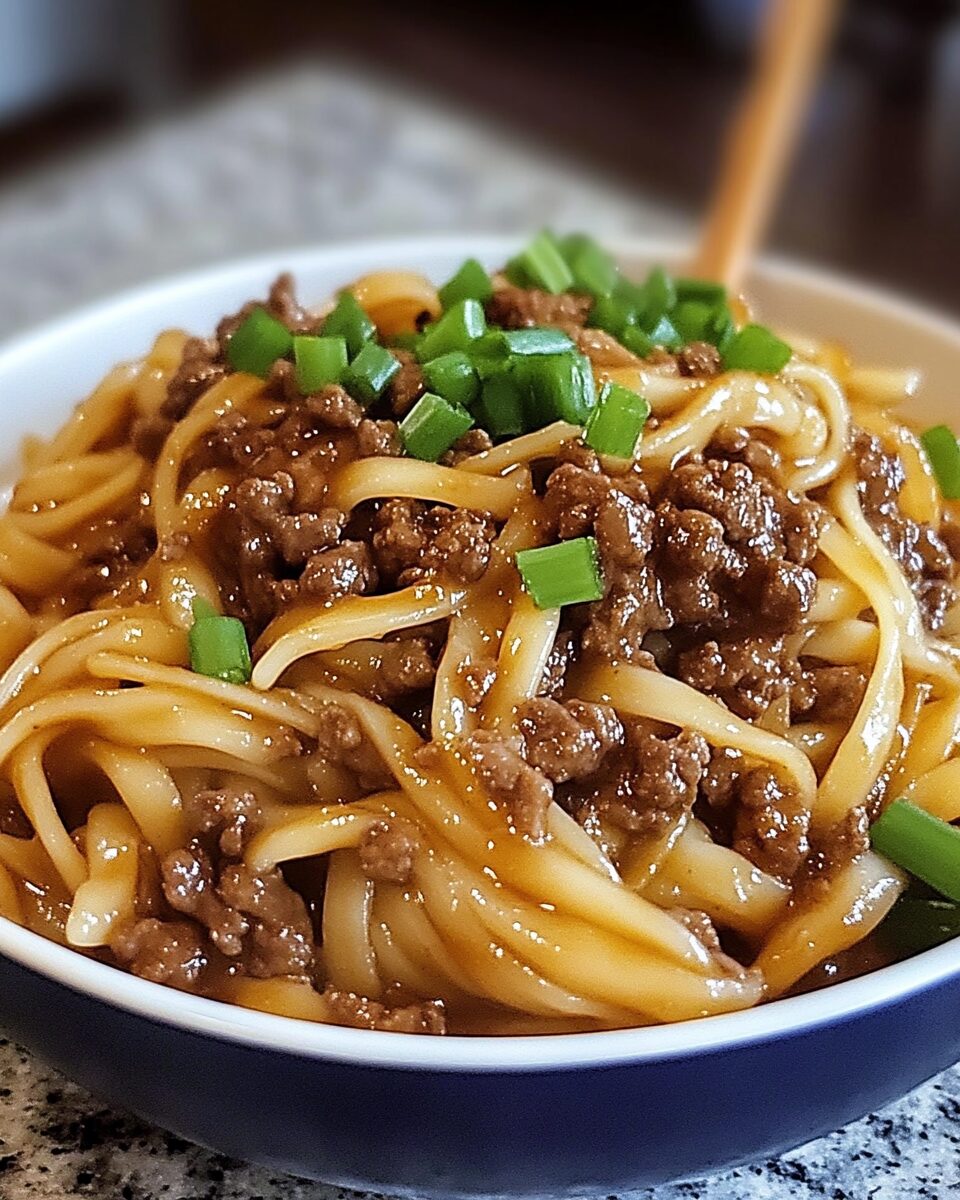The Mongolian Ground Beef Noodles dish is a delightful fusion of sweet and savory flavors, combining tender linguine with rich, spiced ground beef. The sauce, a harmonious blend of soy sauce, hoisin, and brown sugar, envelops each strand of pasta, creating a comforting and satisfying meal.
This recipe is perfect for busy weeknights when time is limited but flavor is essential. With simple ingredients and straightforward steps, you can bring a taste of Asian-inspired cuisine to your table in under 30 minutes. Garnished with fresh green onions, this dish not only tastes amazing but also presents beautifully, making it a great option for both family dinners and casual entertaining.
Full Recipe:
Ingredients:
-
1 lb ground beef (preferably lean)
-
5 cloves garlic, minced
-
1/3 cup brown sugar
-
1/4 cup beef broth
-
1/3 cup soy sauce (low sodium if preferred)
-
3 tablespoons hoisin sauce
-
1/2 teaspoon ground ginger
-
1/2 teaspoon ground black pepper
-
Pinch of red pepper flakes (optional)
-
10 oz linguine or preferred long pasta
-
1 tablespoon cornstarch
-
2 tablespoons water
-
4 green onions, sliced
Directions:
-
Cook the linguine in a large pot of salted boiling water until al dente. Drain and set aside.
-
In a large skillet over medium-high heat, brown the ground beef, breaking it into small pieces. Drain excess fat.
-
Add minced garlic to the beef and sauté for about 1 minute until fragrant.
-
Stir in brown sugar, beef broth, soy sauce, hoisin sauce, ground ginger, black pepper, and red pepper flakes. Mix well.
-
In a small bowl, whisk together cornstarch and water until smooth. Add to the skillet and stir to combine.
-
Let the sauce simmer for a few minutes until it thickens.
-
Add the cooked linguine to the skillet and toss to coat the noodles evenly with the sauce.
-
Simmer for an additional 2-3 minutes to allow flavors to meld.
-
Garnish with sliced green onions and serve hot.
Prep Time: 10 minutes | Cooking Time: 15 minutes | Total Time: 25 minutes
Kcal: 450 kcal | Servings: 4 servings
The Allure of Mongolian Ground Beef Noodles
Mongolian Ground Beef Noodles is a dish that seamlessly blends the rich flavors of Mongolian cuisine with the comforting texture of noodles. This recipe has gained popularity for its simplicity, affordability, and the delightful balance of sweet and savory flavors that appeal to a wide range of palates.
Origins and Cultural Significance
While the term “Mongolian” in the dish’s name suggests a direct link to Mongolian cuisine, it’s essential to note that this recipe is more of an American adaptation inspired by Mongolian flavors. Traditional Mongolian cuisine is known for its emphasis on meats and dairy, with dishes like “buuz” (steamed dumplings) and “khorkhog” (meat cooked with hot stones). The Mongolian Ground Beef Noodles we know today likely evolved from the American-Chinese dish “Mongolian Beef,” which features sliced beef in a savory brown sauce.
This adaptation caters to the Western palate, incorporating readily available ingredients and simplifying the cooking process without compromising on flavor. The result is a dish that resonates with the essence of Mongolian-inspired flavors while being accessible and easy to prepare.
Key Ingredients and Their Roles
Understanding the components of Mongolian Ground Beef Noodles can enhance appreciation for the dish and allow for informed substitutions or enhancements.
- Ground Beef
The foundation of the dish, ground beef provides a hearty and flavorful base. Opting for lean ground beef ensures a balance between taste and health considerations. The beef’s richness complements the sauce, absorbing its flavors and adding depth to the overall dish.
- Garlic and Ginger
These aromatic ingredients are quintessential in Asian cooking. Garlic imparts a pungent, savory note, while ginger adds a zesty warmth. Together, they create a fragrant base that elevates the dish’s complexity.
- Soy Sauce
A staple in many Asian cuisines, soy sauce introduces a salty umami flavor that enhances the beef’s savoriness. Using low-sodium soy sauce can help control the dish’s salt content without sacrificing taste.
- Hoisin Sauce
This thick, fragrant sauce contributes sweetness and depth, balancing the saltiness of the soy sauce. Its unique flavor profile, derived from fermented soybeans, garlic, and various spices, adds authenticity to the dish.
- Brown Sugar
Adding brown sugar introduces a subtle sweetness that contrasts with the savory elements. It also aids in caramelizing the beef, enhancing the dish’s overall flavor and appearance.
- Beef Broth
Incorporating beef broth deepens the meaty flavor and adds moisture, creating a cohesive sauce that coats the noodles effectively.
- Cornstarch Slurry
A mixture of cornstarch and water, this slurry thickens the sauce, ensuring it clings to the noodles and beef, providing a satisfying texture with each bite.
- Noodles
While linguine or spaghetti are commonly used due to their availability, rice noodles or egg noodles can offer a more authentic texture. The choice of noodles can influence the dish’s final mouthfeel and presentation.
- Green Onions and Sesame Seeds
These garnishes add freshness and a slight crunch, enhancing both the visual appeal and the flavor profile of the dish.
Nutritional Considerations
Mongolian Ground Beef Noodles is a dish that can be tailored to meet various dietary preferences and nutritional goals.
-
Protein: The ground beef provides a substantial protein source, essential for muscle repair and overall health.
-
Carbohydrates: Noodles contribute carbohydrates, offering energy. Choosing whole-grain noodles can increase fiber content.
-
Fats: Using lean beef and controlling added oils can manage the dish’s fat content.
-
Sodium: Opting for low-sodium soy sauce and moderating hoisin sauce usage can reduce sodium levels.
-
Vegetables: Incorporating additional vegetables like bell peppers, broccoli, or snap peas can enhance the dish’s nutritional profile, adding vitamins, minerals, and fiber.
Variations and Customizations
One of the strengths of Mongolian Ground Beef Noodles is its adaptability. Here are some variations to consider:
-
Protein Alternatives: Substitute ground beef with ground turkey, chicken, or plant-based meat alternatives for different flavor profiles or dietary needs.
-
Vegetarian Version: Replace meat with tofu or tempeh and use vegetable broth to create a vegetarian-friendly dish.
-
Spice Level: Adjust the amount of red pepper flakes or add chili paste to increase or decrease spiciness according to preference.
-
Noodle Choices: Experiment with different noodles like udon, soba, or rice noodles to alter texture and taste.
-
Additional Vegetables: Incorporate vegetables such as mushrooms, zucchini, or carrots to add variety and nutrition.
Cooking Tips for Optimal Results
-
Preparation: Have all ingredients prepped and ready before cooking, as the process moves quickly.
-
Browning the Beef: Ensure the ground beef is well-browned to develop flavor through the Maillard reaction.
-
Sauce Consistency: Monitor the sauce’s thickness, adjusting the cornstarch slurry as needed to achieve the desired consistency.
-
Noodle Integration: Add noodles to the sauce and beef mixture, allowing them to absorb flavors and ensuring even coating.
-
Garnishing: Apply garnishes just before serving to maintain their freshness and texture.
Serving Suggestions
Mongolian Ground Beef Noodles can be served as a standalone dish or accompanied by sides to create a more elaborate meal.
-
Side Dishes: Pair with steamed vegetables, a light salad, or Asian-style pickled vegetables to complement the flavors.
-
Beverages: Serve with green tea or a light beer to balance the dish’s richness.
-
Presentation: Garnish with additional green onions, sesame seeds, or a drizzle of sesame oil for enhanced flavor and visual appeal.
Storage and Reheating
-
Refrigeration: Store leftovers in an airtight container in the refrigerator for up to 3 days.
-
Freezing: While possible, freezing may alter the noodles’ texture. If freezing, consider storing the sauce and noodles separately.
-
Reheating: Reheat gently on the stovetop or in the microwave, adding a splash of water or broth to loosen the sauce if necessary.
Conclusion
Mongolian Ground Beef Noodles is a delightful fusion dish that marries the bold flavors of Mongolian-inspired cuisine with the comforting texture of noodles. This recipe offers a harmonious blend of savory ground beef, aromatic spices, and tender noodles, making it a favorite for many. Its simplicity and adaptability allow for various modifications to cater to different dietary preferences, such as substituting ground beef with plant-based alternatives or incorporating gluten-free noodles. Adding vegetables like bell peppers, broccoli, or snap peas not only enhances the nutritional value but also introduces vibrant colors and textures to the plate.
Understanding the cultural roots of Mongolian cuisine enriches the cooking experience. Traditional Mongolian dishes often emphasize hearty meats and simple preparations, reflecting the nomadic lifestyle of its people. By integrating these elements into modern recipes, we pay homage to a rich culinary heritage while adapting it to contemporary palates. In conclusion, Mongolian Ground Beef Noodles is more than just a meal; it’s a culinary journey that bridges traditional flavors with modern convenience. Its ease of preparation, coupled with the depth of flavor, makes it an ideal choice for weeknight dinners, meal prepping, or entertaining guests. By experimenting with different ingredients and techniques, you can make this dish uniquely yours, ensuring it remains a staple in your cooking repertoire for years to come.






